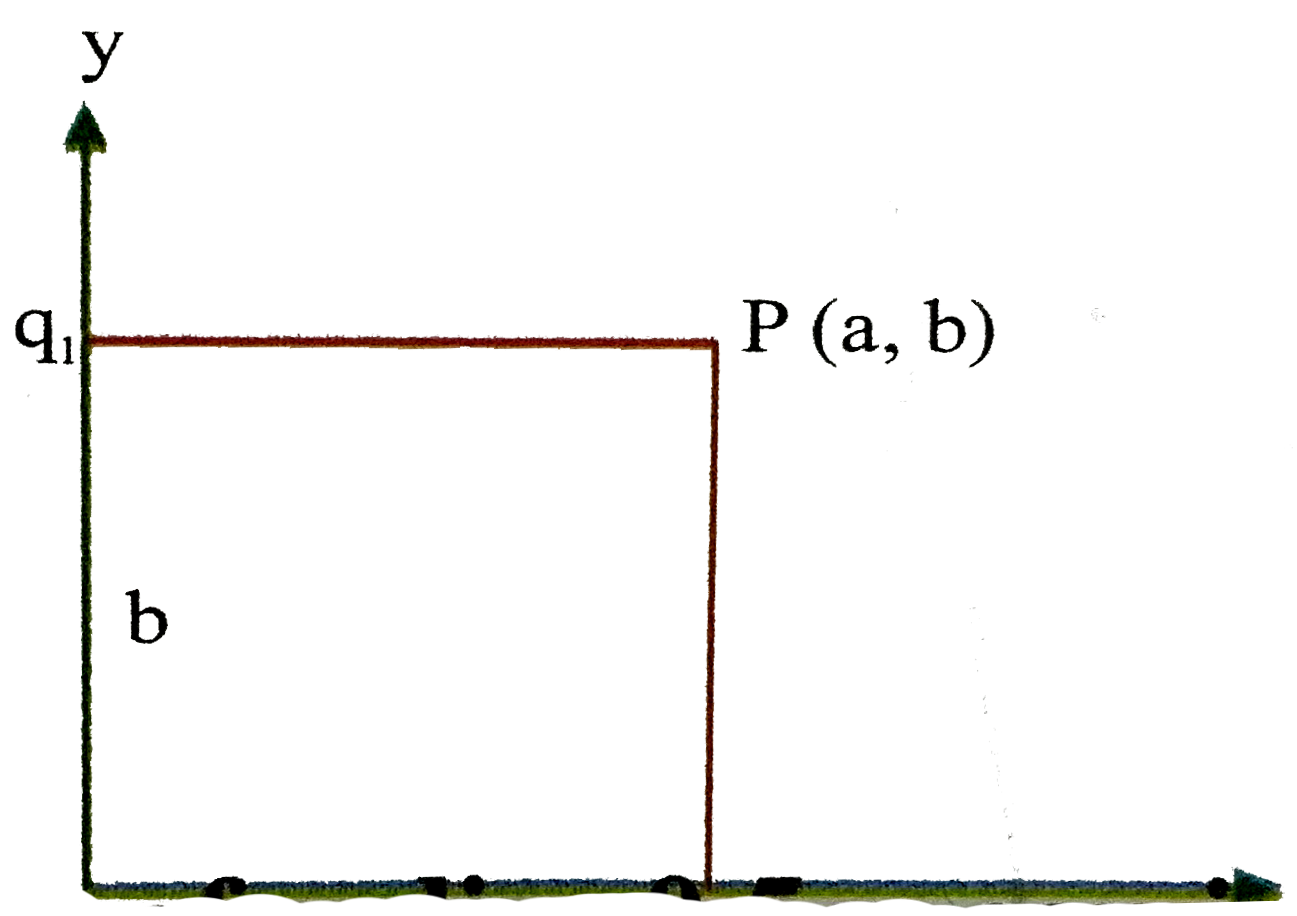Two point charges q1=20μC and q2=25μC are placed at (-1, 1, 1) m and (3, 1, -2)m, with respect to a coordinate system. Find the magnitude and unit vector along electrostatic force on q2 ?
The correct Answer is:|F|=0.18N,ˆF=(4ˆi−3ˆk)5.
To solve the problem of finding the magnitude and unit vector along the electrostatic force on charge q2 due to charge q1, we can follow these steps:
Step 1: Identify the coordinates and charges
The coordinates of the charges are:
- q1=20μC at (−1,1,1)m
- q2=25μC at (3,1,−2)m
Step 2: Calculate the distance r between the charges
The distance r between the two charges can be calculated using the distance formula in 3D:
r=√(x2−x1)2+(y2−y1)2+(z2−z1)2
Substituting the coordinates:
r=√(3−(−1))2+(1−1)2+(−2−1)2
=√(3+1)2+(0)2+(−3)2
=√42+0+(−3)2
=√16+0+9=√25=5m
Step 3: Calculate the magnitude of the electrostatic force F
Using Coulomb's law, the magnitude of the electrostatic force F is given by:
F=k|q1q2|r2
Where k=9×109Nm2/C2. Substituting the values:
F=9×109|20×10−6×25×10−6|52
=9×109500×10−1225
=9×109×20×10−12
=0.18N
Step 4: Determine the direction of the force
The direction of the force can be represented by the vector →r from q1 to q2:
→r=(3−(−1))^i+(1−1)^j+(−2−1)^k
=(4)^i+(0)^j+(−3)^k
Thus, →r=4^i+0^j−3^k.
Step 5: Calculate the unit vector ^r
The unit vector ^r in the direction of →r is given by:
^r=→r|→r|
Where |→r|=r=5m:
^r=4^i+0^j−3^k5
=45^i+0^j−35^k
Final Results
- The magnitude of the electrostatic force on q2 is 0.18N.
- The unit vector along the electrostatic force on q2 is 45^i−35^k.
The coordinates of the charges are:
- q1=20μC at (−1,1,1)m
- q2=25μC at (3,1,−2)m
The distance r between the two charges can be calculated using the distance formula in 3D:
r=√(x2−x1)2+(y2−y1)2+(z2−z1)2
Substituting the coordinates:
r=√(3−(−1))2+(1−1)2+(−2−1)2
=√(3+1)2+(0)2+(−3)2
=√42+0+(−3)2
=√16+0+9=√25=5m
Using Coulomb's law, the magnitude of the electrostatic force F is given by:
F=k|q1q2|r2
Where k=9×109Nm2/C2. Substituting the values:
F=9×109|20×10−6×25×10−6|52
=9×109500×10−1225
=9×109×20×10−12
=0.18N
The direction of the force can be represented by the vector →r from q1 to q2:
→r=(3−(−1))^i+(1−1)^j+(−2−1)^k
=(4)^i+(0)^j+(−3)^k
Thus, →r=4^i+0^j−3^k.
The unit vector ^r in the direction of →r is given by:
^r=→r|→r|
Where |→r|=r=5m:
^r=4^i+0^j−3^k5
=45^i+0^j−35^k
- The magnitude of the electrostatic force on q2 is 0.18N.
- The unit vector along the electrostatic force on q2 is 45^i−35^k.
Topper's Solved these Questions
- BOOK - RESONANCE ENGLISHCHAPTER - ELECTROSTATICSEXERCISE - Exercise-1 Section (B)12videos
ELECTROSTATICS
- BOOK - RESONANCE ENGLISHCHAPTER - ELECTROSTATICSEXERCISE - Exercise-1 Section (C)14videos
ELECTROSTATICS
- BOOK - RESONANCE ENGLISHCHAPTER - ELECTROSTATICSEXERCISE - Problems22videos
ELECTROSTATICS
- BOOK - RESONANCE ENGLISHCHAPTER - ELECTROMAGNETIC INDUCTIONEXERCISE - A.l.P19videos
ELECTROMAGNETIC INDUCTION
- BOOK - RESONANCE ENGLISHCHAPTER - EXPERIMENTAL PHYSICSEXERCISE - PART -II10videos
EXPERIMENTAL PHYSICS
Similar Questions
Two point charges 3μC and 2.5μC are placed at point A (1, 1, 2)m and B (0, 3, -1)m respectively. Find out electric field intensity at point C(3, 3, 3)m.
View SolutionThree point charge q1=1μC,q2=−2μC and q3=3μC are placed at (1m,0,0),(0,2m,0) and (0,0,3m) respectively. Find the electric potential at as origin.
View SolutionTwo charges q1andq2 are placed at (0,0,d) and (0,0,-d) respectively. Find locus of points where the potential is zero.
View SolutionTwo point charge q1=2μC and q2=1μC are placed at distance b=1 and a=2cm from the origin on the y and x axes as shown in figure .The electric field vector at point (a,b) will subtend on angle θ with the "x-axis" given by
 View Solution
View SolutionTwo point charge q1=2μC and q2=1μC are placed at distance b=1 and a=2cm from the origin on the y and x axes as shown in figure .The electric field vector at point (a),(b) will subtend on angle θ with the "x-axis" given by
 View Solution
View SolutionTwo point charges qA=3μCandqB=−3μC are located 20cm apart in vacuum. What is the electric field at the mid point of the line joining the two charges.
 View Solution
View SolutionTwo charge Q1=18μC and Q2=−2μC are separated by a distance R, and Q1 is on the left of Q2. The distance of the point where the net electric field is zero is
View SolutionThree charges q1=1μC,q2=−2μC,andq3=−1μC are placed at A(0,0,0),B(−1,2,3,)andC(2,−1,1). Find the potential of the system of three charges at P(1,−2,−1).
View SolutionThree point charges Q1=25μC,Q2=50μC and Q3=100μC, are kept at the corners A, B and C respectively of an equilateral triangle ABC having each side equal to 7.5 m. Calculate the total electrostatic potential energy of the system.
View SolutionTwo point charges Q1=400μCand Q2=100μC are kept fixed, 60 cm apart in vacuum. Find intensity of the electric field at midpoint of the line joining Q1 and Q2.
View Solution

